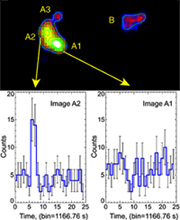November 6, 2000
PSU Press Release
Astronomers using the Chandra X-ray Observatory have identified a flickering, four-way mirage image of a distant quasar. A carefully planned observation of this mirage may be used to determine the expansion rate of the universe as well as to measure the distances to extragalactic objects, arguably two of the most important pursuits in modern astronomy.

This figure is a composite of the X-ray image of the gravitational lens RX J0911.4+551 (top panel) and the light curves of the lensed images A2 (left panel) and A1 (right panel).
Credit: NASA
George Chartas, senior research associate at The Pennsylvania State University (Penn State) and Marshall W. Bautz, principal research scientist at the Massachusetts Institute of Technology (MIT) Center for Space Research, present their findings today at the meeting of the High Energy Astrophysics Division of the American Astronomical Society in Honolulu, Hawaii.
"With a carefully planned follow-up, the Chandra observation of quasar RX J0911.4+0551 may lead to a measurement of the Hubble constant, the expansion rate of the universe, in less than a day," said Chartas. The observation would be done not with mirrors but with mirages--four images of a single quasar that capture the quasar's light at different moments of time due to the speed of light and the location of the mirages.
Quasars are extremely distant galaxies with cores that glow with the intensity of 10 trillion Suns, a phenomenon likely powered by a supermassive black hole in the heart of the galaxy. This single "point source" image of a quasar may appear as four or five sources when the quasar--from our vantage point on Earth--is behind a massive intervening deflector, such as a dim galaxy.
A mirage of images form when the gravity of the intervening deflector forces light rays to bend and take different paths to reach us. The time it takes for light to reach us from the distant object will depend on which path a ray decides to take.
"An intervening galaxy can act as a lens," said Bautz. "Now imagine that the distant lensed quasar suddenly became brighter. The mirage images of the quasar will brighten up at different times depending on the difference in the light travel delay."
Unlike ordinary galaxies, quasars do vary greatly in their intensity, especially in the X-ray waveband, said Gordon Garmire, Evan Pugh Professor of Astronomy and Astrophysics at Penn State. This is caused by the violent and erratic flow of gas into the black hole that is powering the quasar. In quasar RX J0911.4+0551, the astronomers saw a sudden brightening of X-ray intensity that lasted for about 2,000 seconds. This was observed in one of the four mirage images.
Measuring the time-delay of the 2,000-second flare--or any flare-- from mirage to mirage can provide the absolute distance to the deflector (intervening galaxy) and can thus be used to estimate the expansion rate of the universe. Sjur Refsdal first proposed this promising method in 1964. The method avoids many uncertainties associated with the classic distance-ladder technique used to measure objects and the Hubble constant.
The main difficulty in measuring time-delays is that the brightness of each image has to be carefully monitored over several periods of the time-delay. Also, the quasar has to show sufficient variability over time scales smaller than the time-delay. Most attempts to measure time-delays until now have been made in the optical and radio bands. The modest variability of quasars in these wavebands, however, has made it extremely difficult to place accurate constraints on time-delays.
X-ray observations of gravitationally lensed quasars, on the other hand, show strong variability over time scales of hours to days. For example, it has taken almost 20 years of optical and radio monitoring to obtain a universal accepted time-delay for the lensed quasar Q0957+561 to an accuracy of 3percent. Chandra has the potential, the team has found, to determine the time-delay in one observation.
"Based on computer models developed at Penn State and MIT, we have identified about ten gravitational lens systems with time-delays of less than a day," said Chartas. "One long observation of each source with a superior X-ray telescope could provide enough data to nail down the Hubble constant in the blink of an eye." The team is planning to apply the gravitational-lens method in the near future to several of these systems using the Chandra and XMM-Newton X-ray observatories.
The Chandra observations of quasar RX J0911.4+0551 were made on November 2, 1999, using the Advanced CCD Imaging Spectrometer (ACIS). The effort involved several scientists from Penn State and MIT.
ACIS was conceived and developed for NASA by Penn State and MIT under Garmire's leadership. NASA's Marshall Space Flight Center in Huntsville, Alabama, manages the Chandra program. TRW, Inc., in Redondo Beach, California, is the prime contractor for the spacecraft. The Smithsonian's Chandra X-ray Center controls science and flight operations from Cambridge, Massachusetts.
To follow Chandra's progress, visit the Chandra site at:


